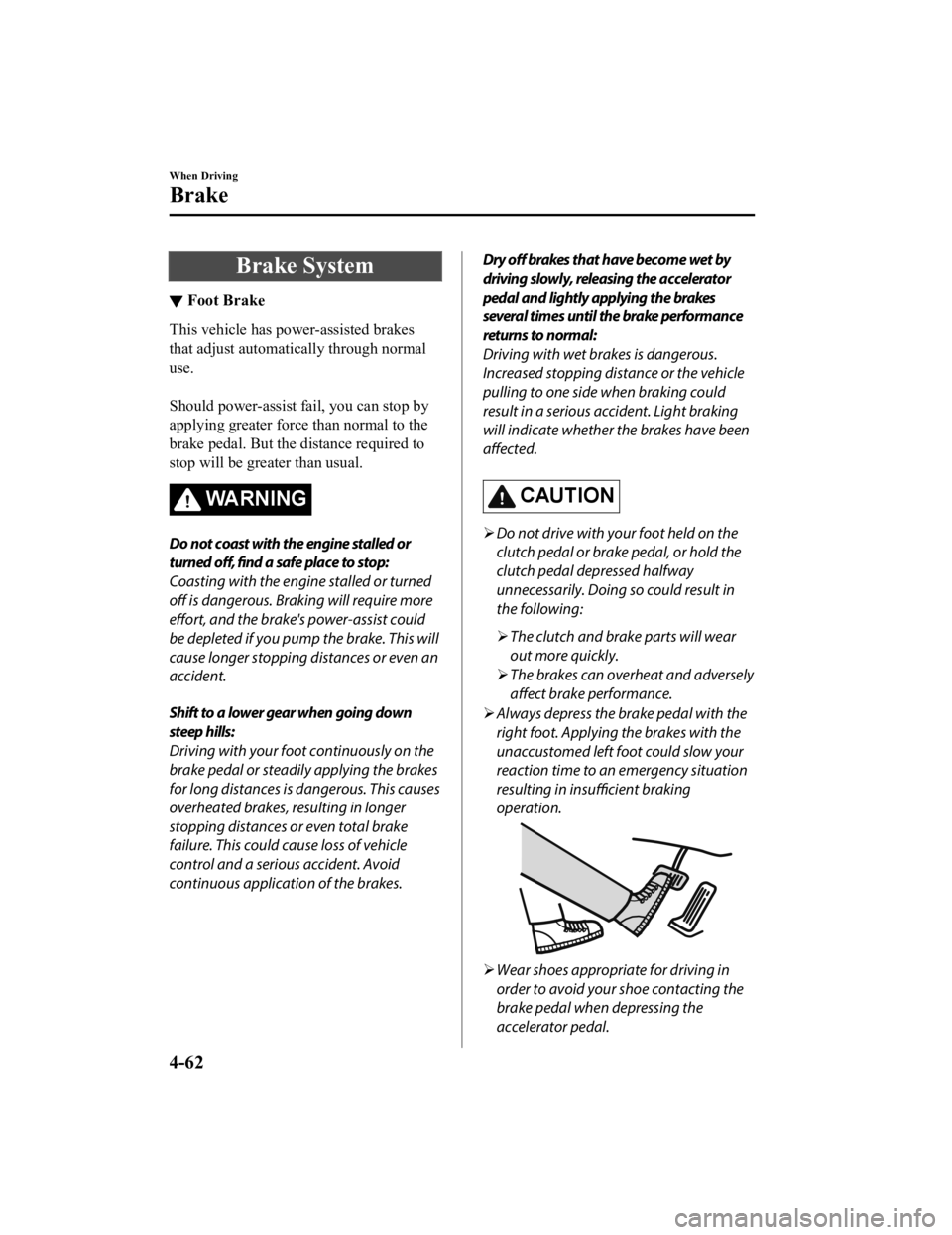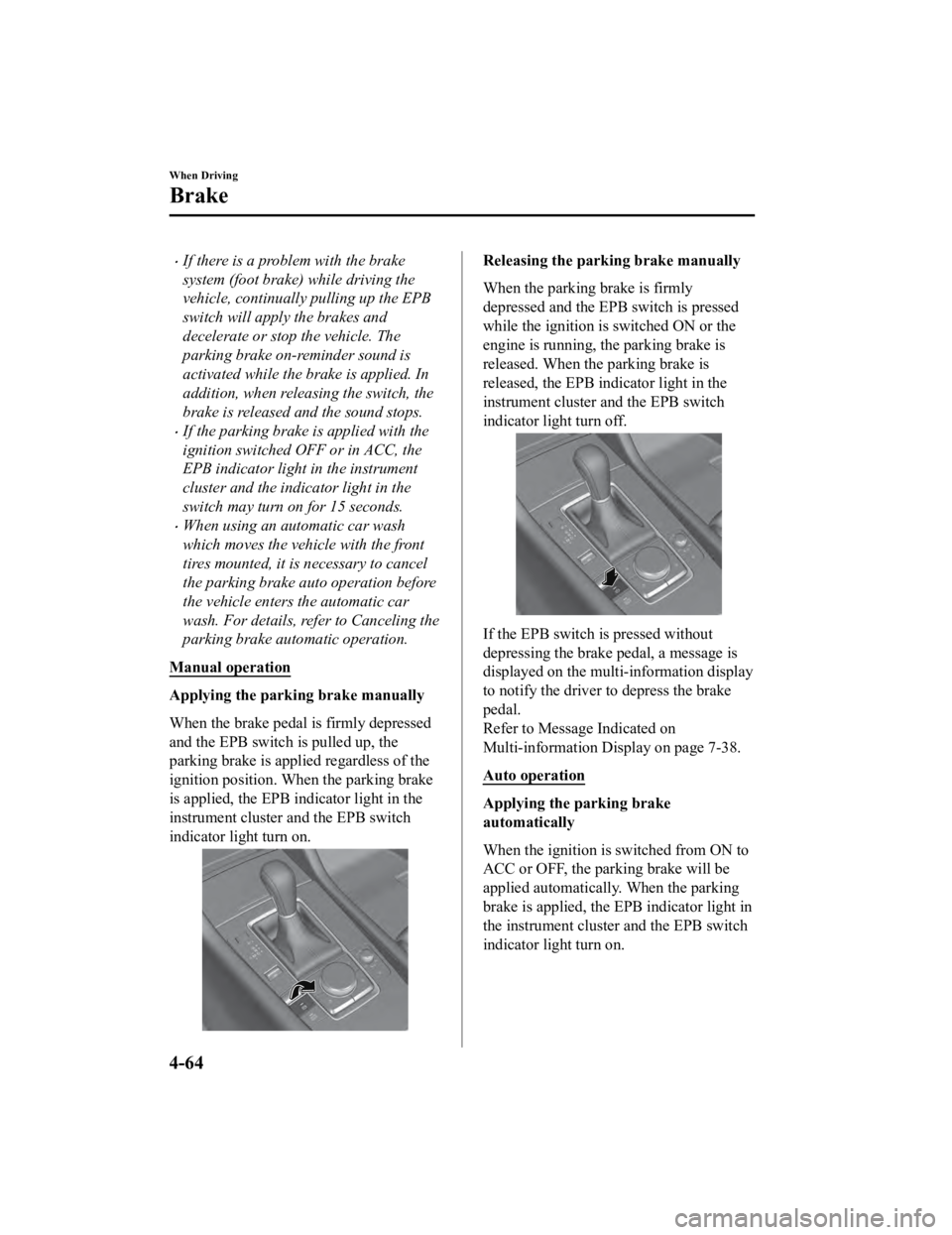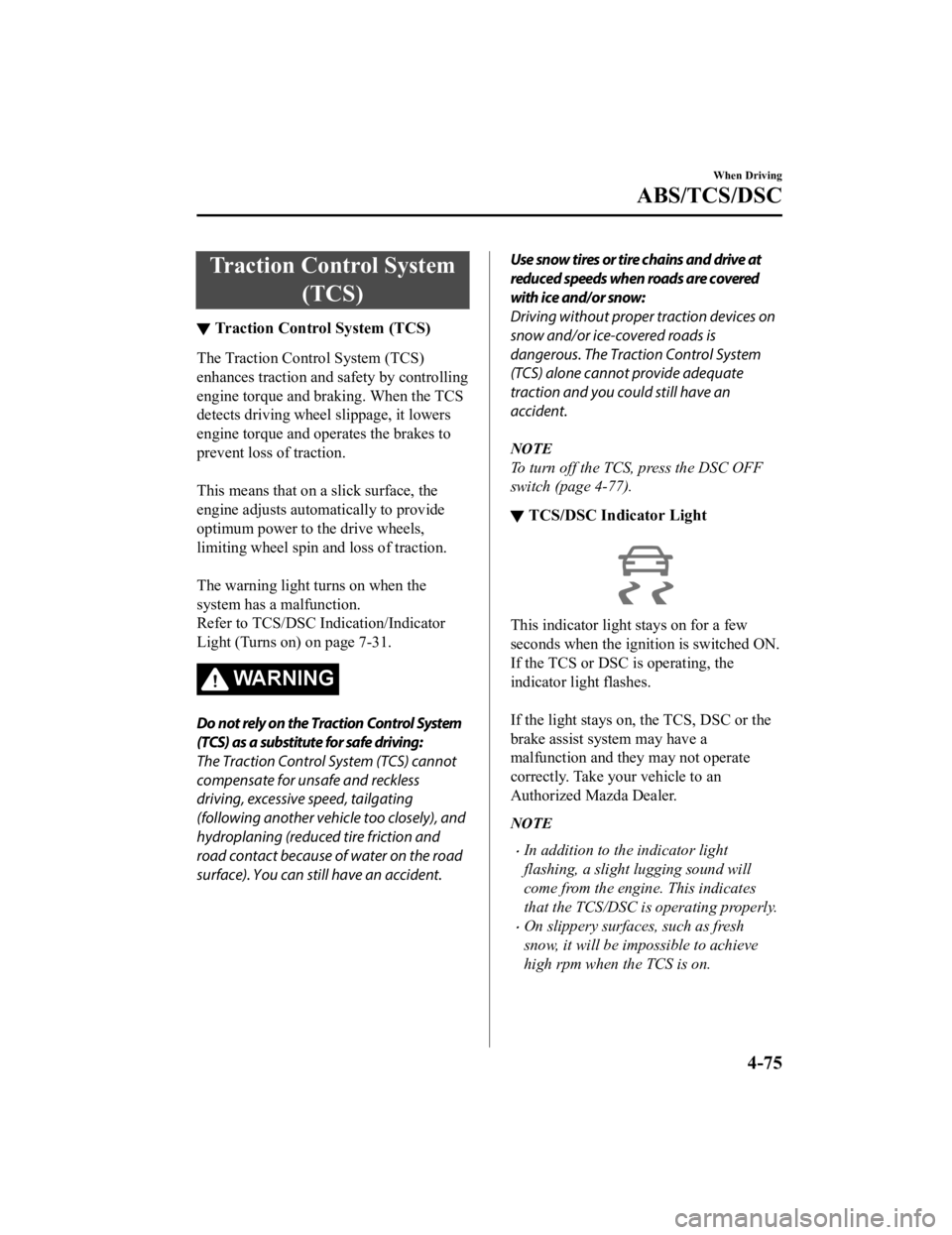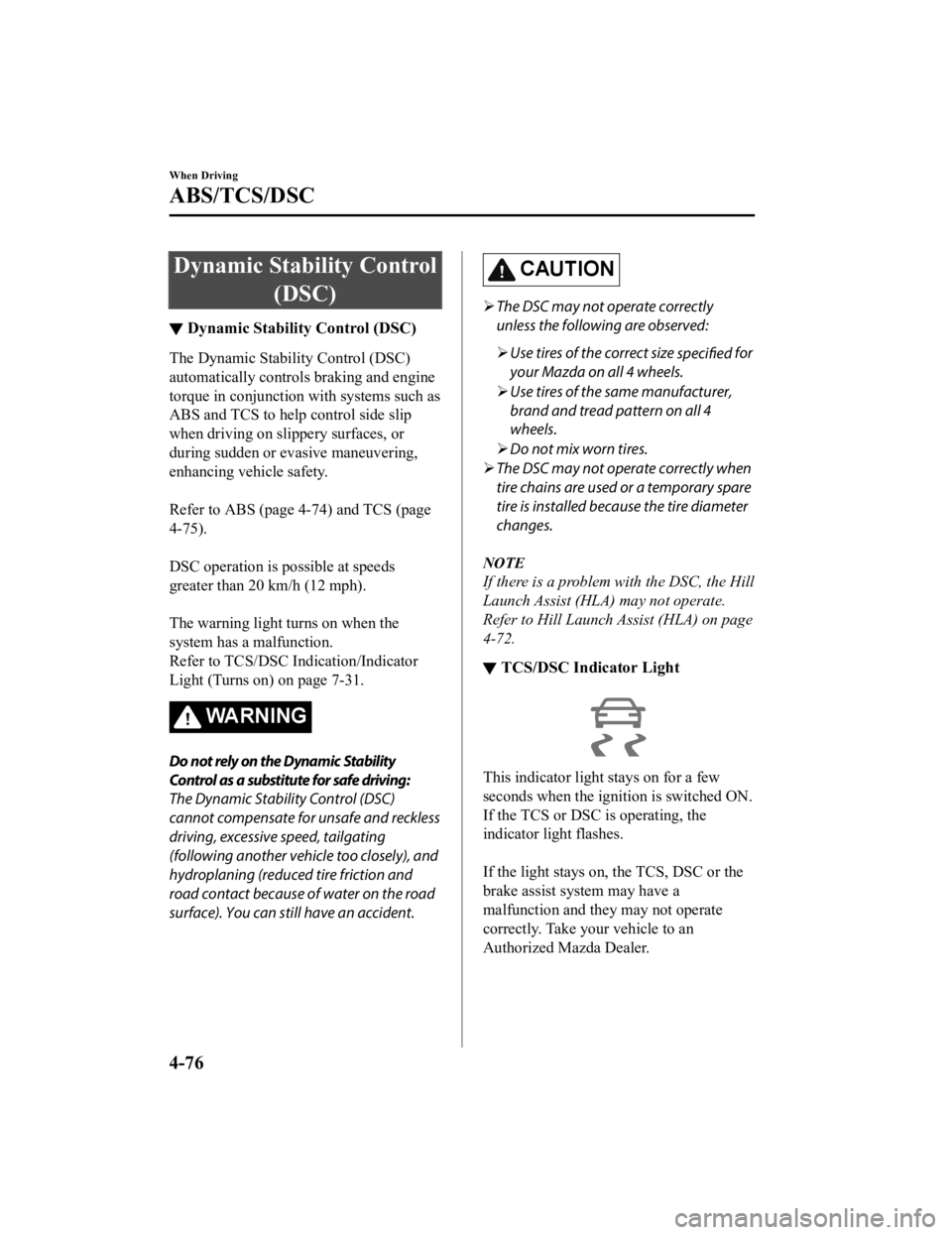engine MAZDA MODEL 3 SEDAN 2019 Workshop Manual
[x] Cancel search | Manufacturer: MAZDA, Model Year: 2019, Model line: MODEL 3 SEDAN, Model: MAZDA MODEL 3 SEDAN 2019Pages: 592, PDF Size: 75.35 MB
Page 184 of 592

*2 When the light switch is switched to a different position from the , position while the vehicle is
stopped, the daytime running lights turn off. When starting to drive the vehicle, the daytime running lights turn
on again.
*3 When the ignition is switched from ON to ACC or OFF, the headl ights remain on if the auto headlight off
function has been canceled. If the auto headlight off function is enabled, the lights turn on for the set period
using the auto headlight off function, and then they turn off.
With auto-light control
Switch Position*1Surround‐
ings are
bright
*2
Surround‐ ings are
dark
*3
Surround‐ ings are
bright
*2
Surround‐ ings are
dark
*3
Headlights Off Off On Off
On*4*5On*6
Daytime running lightsOff
On*7Off On*8Off Off
Taillights
Parking lights
License plate lights
Side-marker lights Off Off On
On
*9On*9On*6
*1 When the light switch is switched to OFF while the vehicle is stopped, the lights turn off. The light switch
returns automatically to the
position and the headlights ch ange to AUTO operation when you start
driving the vehicle.
*2 The level of brightness around the vehicle is of a sufficient level.*3 The level of brightness around the vehicle is of an insufficie nt level.*4 The daytime running lights can be disabled using the personali zation features (page 4-48). If the daytime
running lights are disabled, the headlights turn off directly a fter starting the engine. The headlights turn on
when you begin driving the vehicle.
*5 When the light switch is switched from the , , or position to the position while
the vehicle is stopped, the head lights turn off. When starting to drive the vehicle, the headlights turn on again.
*6 When the ignition is switched from ON to ACC or OFF, the headl ights turn off if the auto headlight off
function has been canceled. If the auto headlight off function is enabled, the lights turn on for the set period
using the auto headlight off function, and then they turn off.
*7 When the light switch is switc hed to a different position from the position while the vehicle is
stopped, the daytime running lights turn off. When starting to drive the vehicle, the daytime running lights turn
on again.
When Driving
Switches and Controls
4-44
Mazda3_8HE9-EA-18K_Edition3 2018-11-21 14:31:58
Page 185 of 592

*8 If one of the following operations is done from the position while the vehicle is stopped, the daytime
running lights turn off.
Switch the light s witch to the position.
Switch the light switch to the position, and then to the position again.
Switch the light switch to the position.
When starting to drive the vehicle, the daytime running lights turn on again.
*9 When the ignition is switched from ON to ACC or OFF, the headlights remain on if the auto headlight off
function has been canceled. If the auto headlight off function is enabled, the lights turn on for the set period
using the auto headlight off function, and then they turn off.
Auto-light control
When the headlight switch is in the
position and the ignition is switched ON, the
light sensor senses the surrounding lightness or darkness and automatically turns the
headlights and other exterior lights on or off.
CAUTION
Do not shade the light sensor by adhering a st icker or a label on the windshield. Otherwise
the light sensor will not operate correctly.
The light sensor also works as a rain sensor for the auto-wiper control. Keep hands and
scrapers clear of the windshield when the wiper lever is in the
position and the
ignition is switched ON as fingers could be pinched or the wipers and wiper blades could be
damaged when the wipers activa te automatically. If you are going to clean the windshield,
be sure the wipers are turned off completely when it is partic
ularly tempting to leave the
engine running. This is particularly important when clearing ice and snow.
NOTE
The headlights and other exterior lights may not turn off immediately even if the
surrounding area becomes well-lit because the light sensor determines that it is night time
if the surrounding area is continuously dark for several minute s such as inside long
tunnels, traffic jams inside tunn els, or in indoor parking lots.
When Driving
Switches and Controls
4-45
Mazda3_8HE9-EA-18K_Edition3 2018-11-21 14:31:58
Page 192 of 592

CAUTION
Do not shade the rain sensor by adhering
a sticker or a label on the windshield.
Otherwise the rain sensor will not
operate correctly.
When the wiper lever is in the
position and the ignition is switched ON,
the wipers may move automatically in
the following cases:
If the windshield above the rain sensor
is touched or wiped with a cloth.
If the windshield is struck with a hand
or other object from either outside or
inside the vehicle.
Keep hands and scrapers clear of the
windshield when the wi per lever is in the
position and the ignition is
switched ON as fingers could be pinched
or the wipers and wiper blades damaged
when the wipers activate automatically.
If you are going to clean the windshield,
be sure the wipers are turned off
completely (when it is most likely that the
engine is left running) this is particularly
important when clearing ice and snow.
NOTE
Switching the auto-wiper lever from the
to the position while
driving activates the windshield wipers
once, after which they operate
according to the rainfall amount.
The auto-wiper control may not operate
when the rain sensor temperature is
about
-10 °C (14 °F) or lower, or
about 85 °C (185 °F) or higher.
If the windshield is coated with water
repellent, the rain sensor may not be
able to sense the amount of rainfall
correctly and the auto-wiper control
may not operate properly.
If dirt or foreign matter (such as ice or
matter containing salt water) adheres to
the windshield above the rain sensor, or
if the windshield is iced, it could cause
the wipers to move automatically.
However, if the wi pers cannot remove
this ice, dirt or foreign matter, the
auto-wiper control will stop operation.
In this case, set th e wiper lever to the
low speed position or high speed
position for manual operation, or
remove the ice, dirt or foreign matter by
hand to restore the auto-wiper
operation.
If the auto-wiper lever is left in the
position, the wipers could
operate automatically from the effect of
strong light sources, electromagnetic
waves, or infrared light because the rain
sensor uses an optical sensor. It is
recommended that the auto-wiper lever
be switched to the
position other
than when driving the vehicle under
rainy conditions.
When Driving
Switches and Controls
4-52
Mazda3_8HE9-EA-18K_Edition3 2018-11-21 14:31:58
Page 202 of 592

Brake System
▼Foot Brake
This vehicle has power-assisted brakes
that adjust automatically through normal
use.
Should power-assist fail, you can stop by
applying greater force than normal to the
brake pedal. But the d
istance required to
stop will be greater than usual.
WA R N I N G
Do not coast with the engine stalled or
turned off,
find a safe place to stop:
Coasting with the engine stalled or turned
off is dangerous. Braking will require more
effort, and the brake's power-assist could
be depleted if you pump the brake. This will
cause longer stopping distances or even an
accident.
Shift to a lower gear when going down
steep hills:
Driving with your foot continuously on the
brake pedal or steadily applying the brakes
for long distances is dangerous. This causes
overheated brakes, resulting in longer
stopping distances or even total brake
failure. This could cause loss of vehicle
control and a serious accident. Avoid
continuous application of the brakes.
Dry off brakes that have become wet by
driving slowly, releasing the accelerator
pedal and lightly applying the brakes
several times until the brake performance
returns to normal:
Driving with wet brakes is dangerous.
Increased stopping distance or the vehicle
pulling to one side when braking could
result in a serious accident. Light braking
will indicate whether the brakes have been
affected.
CAUTION
Do not drive with your foot held on the
clutch pedal or brake pedal, or hold the
clutch pedal depressed halfway
unnecessarily. Doing so could result in
the following:
The clutch and brake parts will wear
out more quickly.
The brakes can overheat and adversely
affect brake performance.
Always depress the brake pedal with the
right foot. Applying the brakes with the
unaccustomed left foot could slow your
reaction time to an emergency situation
resulting in insufficient braking
operation.
Wear shoes appropriate for driving in
order to avoid your shoe contacting the
brake pedal when depressing the
accelerator pedal.
When Driving
Brake
4-62
Mazda3_8HE9-EA-18K_Edition3 2018-11-21 14:31:58
Page 204 of 592

If there is a problem with the brake
system (foot brake) while driving the
vehicle, continually pulling up the EPB
switch will apply the brakes and
decelerate or stop the vehicle. The
parking brake on-reminder sound is
activated while the brake is applied. In
addition, when releasing the switch, the
brake is released and the sound stops.
If the parking brake is applied with the
ignition switched OFF or in ACC, the
EPB indicator light in the instrument
cluster and the indicator light in the
switch may turn on for 15 seconds.
When using an automatic car wash
which moves the vehic le with the front
tires mounted, it is necessary to cancel
the parking brake auto operation before
the vehicle enters the automatic car
wash. For details, refe r to Canceling the
parking brake automatic operation.
Manual operation
Applying the parking brake manually
When the brake pedal is firmly depressed
and the EPB switch is pulled up, the
parking brake is applied regardless of the
ignition position. Whe n the parking brake
is applied, the EPB in dicator light in the
instrument cluster and the EPB switch
indicator light turn on.
Releasing the parking brake manually
When the parking brake is firmly
depressed and the EPB switch is pressed
while the ignition is switched ON or the
engine is running, the parking brake is
released. When the parking brake is
released, the EPB indicator light in the
instrument cluster a nd the EPB switch
indicator light turn off.
If the EPB switch is pressed without
depressing the brake pedal, a message is
displayed on the multi-information display
to notify the driver to depress the brake
pedal.
Refer to Message Indicated on
Multi-information Display on page 7-38.
Auto operation
Applying the parking brake
automatically
When the ignition is switched from ON to
ACC or OFF, the parking brake will be
applied automatically. When the parking
brake is applied, the EPB indicator light in
the instrument cluster and the EPB switch
indicator light turn on.
When Driving
Brake
4-64
Mazda3_8HE9-EA-18K_Edition3 2018-11-21 14:31:58
Page 205 of 592

NOTE
To release the parking brake when the
ignition is switched OFF, it is necessary to
cancel the parking brake auto operation.
For details, refer to Canceling the parking
brake automatic operation.
Releasing the parking brake
automatically
If the accelerator pe dal is depressed with
the parking brake applied and all of the
following conditions met, the parking
brake is released automatically. When the
parking brake is released, the EPB
indicator light in the instrument cluster
and the EPB switch indicator light turn
off.
The engine is running.
The driver's door is closed.
The driver's seat belt is fastened.
(Manual transmission vehicle)
The shift lever is in a position other
than neutral.
The clutch pedal is depressed halfway.
(Automatic transmission vehicle)
The selector lever is in the D, M, or R
position.
NOTE
If something such as the driver's foot
contacts the accelerator pedal with the
engine running and the parking brake
applied, the parking brake might be
released automatically. If you do not
intend to start driving the vehicle
immediately, shift the shift lever to the
neutral position for a manual
transmission, or shift the selector lever to
the P or N position for an automatic
transmission.
Canceling the parking brake automatic
operation
The parking brake automatic operation can
be canceled by doing any of the following
after switching the ignition from ON to
OFF.
Auto operation cancel method 1
1. Switch the ignition ON.
2. Turn off the AUTOHOLD.
3. Press the EPB switch continuously for 2 seconds or longer (until a sound is
activated).
4. Release the EPB switch and switch the ignition OFF within 5 seconds after the
sound was activated.
After the auto opera tion is canceled, a
sound is activated one time, and the
EPB switch indicator light switches
from illumination to flashing, and then
turns off after 3 seconds.
Auto operation cancel method 2
1. Switch the ignition ON.
2. Turn off the AUTOHOLD.
3. Switch the ignition OFF with the EPB switch pressed.
When the auto operation is canceled, a
sound is activated one time, and the
EPB switch indicator light from
normal flashing to faster flashing, and
then turns off after 3 seconds.
NOTE
When canceling the parking brake auto
operation and parking the vehicle, shift
the shift lever to the 1st gear or the R
position for a manual transmission, or
shift the selector lever to the P position
for an automatic transmission, and then
use wheel blocks.
When Driving
Brake
4-65
Mazda3_8HE9-EA-18K_Edition3 2018-11-21 14:31:58
Page 210 of 592

▼AUTOHOLD System is Turned On
Press the AUTOHOLD switch and when
the AUTOHOLD standby indicator light
turns on, the AUTOHOLD function turns
on.
1. AUTOHOLD standby indicator light
NOTE
When all of the following conditions are
met, the AUTOHOLD standby indicator
light turns on when the AUTOHOLD
switch is pressed and the AUTOHOLD
function turns on.
The ignition is switched ON (engine is
running).
The driver's seat belt is fastened.
The driver's door is closed.
There is no problem with the
AUTOHOLD function.
To operate AUTOHOLD and hold the
brakes
1. Depress the brake pedal and bring the vehicle to a complete stop.
2. The AUTOHOLD active indicator light in the instrume nt cluster turns on
and the brakes are held.
3. The vehicle is held in its stopped position even with the brake pedal
released.
NOTE
When all of the following conditions are
met, the AUTOHOLD operates and the
brakes are held.
The ignition is switched ON (engine is
running).
The vehicle is stopped.
The brake pedal is being depressed.
The AUTOHOLD active indicator light
turns on.
The accelerator pedal is not depressed.
The driver's seat belt is fastened.
The driver's door is closed.
There is no problem with the
AUTOHOLD function.
The parking brake is released.
There is no problem with the Electric
Parking Brake (EPB) function.
(Automatic transmission vehicle)
The selector lever is in a position other
than R position or the vehicle tilts
forward with the selector lever in the R
position.
To release AUTOHOLD and start
driving the vehicle
If you do any of the following actions to
resume driving the vehicle, the brakes
release automatically and the
AUTOHOLD active indicator light turns
off.
(Manual transmission vehicle)
You start to release the clutch pedal with
the shift lever shifted to a position other
than the neutral position
(Automatic transmission vehicle)
The accelerator pedal is depressed.
When Driving
Brake
4-70
Mazda3_8HE9-EA-18K_Edition3 2018-11-21 14:31:58
Page 214 of 592

Antilock Brake System(ABS)
▼Antilock Brake System (ABS)
The ABS control unit continuously
monitors the speed o
f each wheel. If one
wheel is about to lock up, the ABS
responds by automatically releasing and
reapplying that wheel's brake.
The driver will feel a slight vibration in
the brake pedal and may hear a chattering
noise from the brake system. This is
normal ABS system operation. Continue
to depress the brak e pedal without
pumping the brakes.
The warning light turns on when the
system has a malfunction.
Refer to ABS Warning Indication/Warning
Light on page 7-29.
WA R N I N G
Do not rely on ABS as a substitute for safe
driving:
The ABS cannot compensate for unsafe
and reckless driving, excessive speed,
tailgating (following another vehicle too
closely), driving on ice and snow, and
hydroplaning (reduced tire friction and
road contact because of water on the road
surface). You can still have an accident.
NOTE
Braking distances may be longer on
loose surfaces (snow or gravel, for
example) which usually have a hard
foundation. A vehicle with a normal
braking system may require less
distance to stop under these conditions
because the tires wi ll build up a wedge
of surface layer when the wheels skid.
The sound of the ABS operating may be
heard when starting the engine or
immediately after starting the vehicle,
however, it does not indicate a
malfunction.
When Driving
ABS/TCS/DSC
4-74
Mazda3_8HE9-EA-18K_Edition3 2018-11-21 14:31:58
Page 215 of 592

Traction Control System(TCS)
▼Traction Control System (TCS)
The Traction Control System (TCS)
enhances traction and
safety by controlling
engine torque and braking. When the TCS
detects driving wheel slippage, it lowers
engine torque and operates the brakes to
prevent loss of traction.
This means that on a slick surface, the
engine adjusts automatically to provide
optimum power to the drive wheels,
limiting wheel spin and loss of traction.
The warning light turns on when the
system has a malfunction.
Refer to TCS/DSC Indication/Indicator
Light (Turns on) on page 7-31.
WA R N I N G
Do not rely on the Traction Control System
(TCS) as a substitute for safe driving:
The Traction Control System (TCS) cannot
compensate for unsafe and reckless
driving, excessive speed, tailgating
(following another vehicle too closely), and
hydroplaning (reduced tire friction and
road contact because of water on the road
surface). You can still have an accident.
Use snow tires or tire chains and drive at
reduced speeds when roads are covered
with ice and/or snow:
Driving without proper traction devices on
snow and/or ice-covered roads is
dangerous. The Traction Control System
(TCS) alone cannot provide adequate
traction and you co uld still have an
accident.
NOTE
To turn off the TCS, press the DSC OFF
switch (page 4-77).
▼ TCS/DSC Indicator Light
This indicator light stays on for a few
seconds when the ignition is switched ON.
If the TCS or DSC
is operating, the
indicator light flashes.
If the light stays on, the TCS, DSC or the
brake assist system may have a
malfunction and they may not operate
correctly. Take your vehicle to an
Authorized Mazda Dealer.
NOTE
In addition to the indicator light
flashing, a slight lugging sound will
come from the engine. This indicates
that the TCS/DSC is operating properly.
On slippery surfaces, such as fresh
snow, it will be impossible to achieve
high rpm when the TCS is on.
When Driving
ABS/TCS/DSC
4-75
Mazda3_8HE9-EA-18K_Edition3 2018-11-21 14:31:58
Page 216 of 592

Dynamic Stability Control(DSC)
▼Dynamic Stability Control (DSC)
The Dynamic Stability Control (DSC)
automatically controls braking and engine
torque in conjunction with systems such as
ABS and TCS to help control side slip
when driving on slippery surfaces, or
during sudden or evasive maneuvering,
enhancing vehicle safety.
Refer to ABS (page 4-74) and TCS (page
4-75).
DSC operation is possible at speeds
greater than 20 km/h (12 mph).
The warning light
turns on when the
system has a malfunction.
Refer to TCS/DSC I ndication/Indicator
Light (Turns on) on page 7-31.
WA R N I N G
Do not rely on the Dynamic Stability
Control as a substitute for safe driving:
The Dynamic Stability Control (DSC)
cannot compensate for unsafe and reckless
driving, excessive speed, tailgating
(following another vehicle too closely), and
hydroplaning (reduced tire friction and
road contact because of water on the road
surface). You can still have an accident.
CAUTION
The DSC may not operate correctly
unless the following are observed:
Use tires of the correct size
specified for
your Mazda on all 4 wheels.
Use tires of the same manufacturer,
brand and tread pattern on all 4
wheels.
Do not mix worn tires.
The DSC may not operate correctly when
tire chains are used or a temporary spare
tire is installed because the tire diameter
changes.
NOTE
If there is a problem w ith the DSC, the Hill
Launch Assist (HLA) may not operate.
Refer to Hill Launch Assist (HLA) on page
4-72.
▼ TCS/DSC Indicator Light
This indicator light stays on for a few
seconds when the ignition is switched ON.
If the TCS or DSC is operating, the
indicator light flashes.
If the light stays on, the TCS, DSC or the
brake assist system may have a
malfunction and they may not operate
correctly. Take your vehicle to an
Authorized Mazda Dealer.
When Driving
ABS/TCS/DSC
4-76
Mazda3_8HE9-EA-18K_Edition3
2018-11-21 14:31:58